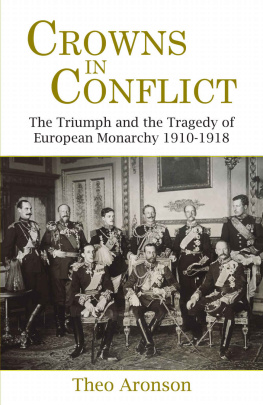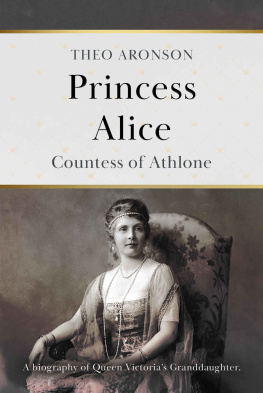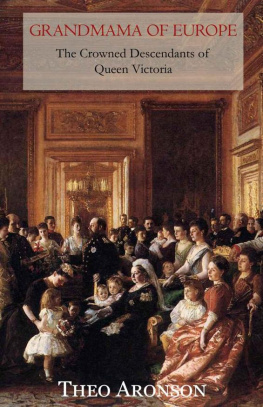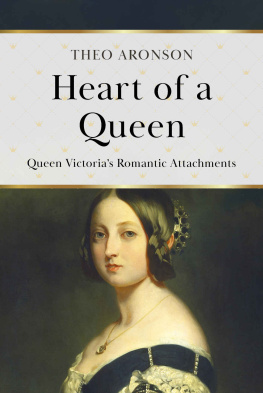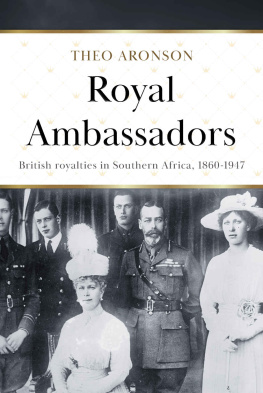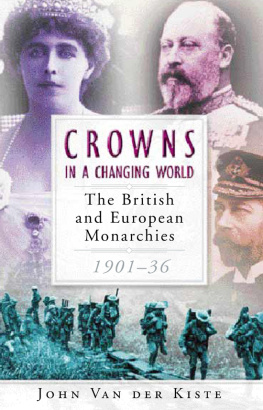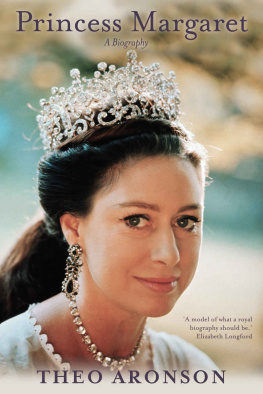Theo Aronson - Crowns in conflict: the triumph and the tragedy of European monarchy, 1910-1918
Here you can read online Theo Aronson - Crowns in conflict: the triumph and the tragedy of European monarchy, 1910-1918 full text of the book (entire story) in english for free. Download pdf and epub, get meaning, cover and reviews about this ebook. year: 2015, publisher: Thistle Publishing, genre: History. Description of the work, (preface) as well as reviews are available. Best literature library LitArk.com created for fans of good reading and offers a wide selection of genres:
Romance novel
Science fiction
Adventure
Detective
Science
History
Home and family
Prose
Art
Politics
Computer
Non-fiction
Religion
Business
Children
Humor
Choose a favorite category and find really read worthwhile books. Enjoy immersion in the world of imagination, feel the emotions of the characters or learn something new for yourself, make an fascinating discovery.
- Book:Crowns in conflict: the triumph and the tragedy of European monarchy, 1910-1918
- Author:
- Publisher:Thistle Publishing
- Genre:
- Year:2015
- Rating:3 / 5
- Favourites:Add to favourites
- Your mark:
- 60
- 1
- 2
- 3
- 4
- 5
Crowns in conflict: the triumph and the tragedy of European monarchy, 1910-1918: summary, description and annotation
We offer to read an annotation, description, summary or preface (depends on what the author of the book "Crowns in conflict: the triumph and the tragedy of European monarchy, 1910-1918" wrote himself). If you haven't found the necessary information about the book — write in the comments, we will try to find it.
Crowns in conflict: the triumph and the tragedy of European monarchy, 1910-1918 — read online for free the complete book (whole text) full work
Below is the text of the book, divided by pages. System saving the place of the last page read, allows you to conveniently read the book "Crowns in conflict: the triumph and the tragedy of European monarchy, 1910-1918" online for free, without having to search again every time where you left off. Put a bookmark, and you can go to the page where you finished reading at any time.
Font size:
Interval:
Bookmark:
Crowns in Conflict
The Triumph and the
Tragedy of European
Monarchy 1910-1918
Theo Aronson
All Rights Reserved
Copyright Theo Aronson 1986, 2015
First published in 1986 by John Murray
This edition published in 2015 by:
Thistle Publishing
36 Great Smith Street
London
SW1P 3BU
www.thistlepublishing.co.uk
For
STELLA and COLLIE HILL
in memory of La Rimade
Contents
Author's Note
T HIS BOOK is not a history of the First World War. Nor is it a political, economic and social survey of Europe from 1910 to 1918. It is a study of European monarchy in the final years of its last great flowering and, more particularly, of the twelve monarchs involved in the conflict of 19141918. The focus, throughout, is on the personal fortunes of these sovereigns; it is biography rather than history.
Whereas the falls of the Romanov, Habsburg and Hohenzollern dynasties have been dealt with before, this is the first time that the entire cast of embattled monarchs including the lesser-known but no less interesting personalities such as the sovereigns of Bulgaria, Montenegro, Romania and Serbia has been assembled in one book. It is the story of eight momentous years viewed, as it were, from the monarchical standpoint. The characters are dealt with in relation to each other, as members of an inter-related and international brotherhood, rather than as individual national sovereigns. It is an account of the passing, not only of their particular world, but of the entire monarchic and dynastic order of the Continent. It describes the brilliant sunset and the dramatic break-up of the Europe of the Kings.
I have received a great deal of help during the writing of this book. I am grateful to Queen Elizabeth The Queen Mother who very kindly gave me her impressions of Queen Marie of Romania; and to the late Princess Alice, Countess of Athlone, for her memories of so many of the characters portrayed in this book, particularly Kaiser Wilhelm II and King Albert and Queen Elisabeth of the Belgians.
Then I must thank those many people who, to a greater or lesser extent, have given me information and assistance. They are, in alphabetical order: Sir Alastair Aird; Dr Becker of the Staatsarchiv Sigmaringen; Dr Horst Brettner-Messler of the Haus- Hof- und Staatsarchiv, Vienna; Mr Gordon Brook-Shepherd; Dr Francesca Di Cesare, Director of the Biblioteca di Storia Moderna e Contemporanea, Rome; Mr S. Clout of the Imperial War Museum; Miss Frances Dimond, Royal Archives, Windsor Castle; Mr Oliver Everett, the Librarian, Windsor Castle; Mrs Irmgard Flett; Dr S.R. Foister; Dr E.G. Franz, Director of the Hessisches Staatsarchiv, Darmstadt; Angela Griffiths; Doreen and Malcolm Jones; Dr Letkemann, Director of the Geheimes Staatsarchiv, Berlin; the Countess of Longford; Mr Antonio Spallone, Librarian at the Instituto Italiano di Cultura, London; Professor Norman Stone; Sir Roy Strong; Mr Emile Vandewoude, Archivist of the Palais Royal, Brussels; Mr R.I.B. Webster; Mr Peter Wilson.
As always, Brian Roberts has given me invaluable advice, encouragement and assistance.
I am grateful to the staffs of the British Library, the Newspaper Library at Colindale, the Bath Reference Library, the Bristol Reference Library, and the Department of Printed Books at the Imperial War Museum. To Mrs S. Bane and the staff of the Frome Library, I am, as always, deeply indebted for their unfailing patience and efficiency.
I must acknowledge the gracious permission of Her Majesty The Queen for the republication of material from the Royal Archives which is subject to copyright. Although I have listed all books consulted in the Bibliography, I am particularly grateful to the authors of the following books: The Last Habsburg by Gordon Brook-Shepherd, Foxy Ferdinand, Tsar of Bulgaria by Stephen Constant and The Fall of the House of Savoy by Robert Katz.
Prologue
'The Pomp of Kings'
O F ALL THE PAGEANTRY that marked the funeral of King Edward VII on 20 May 1910, nothing was more spectacular than the famous 'Parade of Kings'. This was the cavalcade, not only of kings and emperors but of crown princes, archdukes, grand-dukes and princes, that followed the slowly trundling coffin through the streets of London.
Never, declared The Times , had the British capital seen anything 'more splendid, more stately or more impressive'. Over fifty royal horsemennine monarchs, five heirs-apparent, forty imperial, royal and serene highnesses rode through the densely packed streets. Three by three, with plumes fluttering, orders flashing, gold braid glinting and accoutrements all a-jingle, these 'visions', as The Times effusively put it, 'of gold and scarlet and blue and green' passed by in the bright spring sunshine. Behind, in twelve crimson and gold state carriages, came a galaxy of queens and princesses.
Here was a moment of supreme monarchical glory. Never before had such a concourse of royalty been gathered together in one place. What Queen Victoria used to call 'the Royal Mob' was out in force. Republican envoys, no matter how powerful the countries they represented, were firmly relegated to the end of the procession.
To the crowds lining the route from Westminster Hall to Paddington station, some of these royal figures were instantly recognisable. Beside the new British King, George V, rode the German Emperor, Wilhelm II. His features the waxed moustache, the steely gaze, the aggressive bearing, the crippled left arm were as familiar as were the warlike pronouncements by which he regularly sent shivers down the spines of Europe's diplomats. Behind, flanking old King George I of the Hellenes, came two younger sovereigns: King Haakon VII of Norway and King Alfonso XIII of Spain. Between Tsar Ferdinand I of Bulgaria and young King Manoel II of Portugal rode King Frederick VII of Denmark. Finally, with the heir to the Austro-Hungarian empire on his left hand and to the Ottoman empire on his right, came the Continent's newest sovereign, King Albert I of the Belgians.
Here and there, among the assorted royal and imperial highnesses that followed, could be spotted some particularly arresting figure: a Russian grand duke; a Japanese or Chinese prince; the brother of the Khedive of Egypt in a fez; a clutch of Balkan princes in their flat, round caps; a strikingly uniformed Italian duke; a honey-skinned prince of Siam and an olive-skinned prince of Persia; the Crown Prince of Bavaria in a scarlet sash; an Austrian archduke; the Dutch Prince Consort; Prince Danilo of Montenegro who, to the dismay of his British hosts, had arrived in London with an extremely attractive young woman whom he introduced as his absent wife's lady-in-waiting. When the harassed officials expressed grave doubts about the possibility of finding the lady a room in the crowded capital, Prince Danilo remained, they said, remarkably unperturbed.
In the twelve state carriages that followed drove no less than seven queens. With them were assorted princesses and royal duchesses, as well as the younger children of the new British sovereigns, King George and Queen Mary.
Who, seeing this collection of royalty clattering by, could doubt that the institution of kingship was flourishing? Indeed, nothing could better have symbolised the extraordinary early twentieth-century flowering of European monarchy than this swaggering cavalcade. And, with the exception of the more exotic eastern princes, most of these royals were related to each other. The late Edward VII had been known as the Uncle of Europe: and where he had not been the uncle of Europe's various kings and queens, they had been his cousins, or cousins-by-marriage, at several removes. There was hardly a Continental court that did not boast at least one of Edward VII's Coburg relations.
So Edward VII's grandiose funeral served both as a domestic occasion and as a public flourish. It was, as one of the late King's equerries put it, 'as much a family gathering as the mustering of a profession'. It marked, or seemed to mark, an apogee in the long history of Europe's reigning houses.
Next pageFont size:
Interval:
Bookmark:
Similar books «Crowns in conflict: the triumph and the tragedy of European monarchy, 1910-1918»
Look at similar books to Crowns in conflict: the triumph and the tragedy of European monarchy, 1910-1918. We have selected literature similar in name and meaning in the hope of providing readers with more options to find new, interesting, not yet read works.
Discussion, reviews of the book Crowns in conflict: the triumph and the tragedy of European monarchy, 1910-1918 and just readers' own opinions. Leave your comments, write what you think about the work, its meaning or the main characters. Specify what exactly you liked and what you didn't like, and why you think so.

